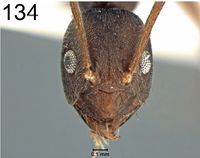Paratrechina umbra
| Paratrechina umbra | |
|---|---|

| |
| Scientific classification | |
| Kingdom: | Animalia |
| Phylum: | Arthropoda |
| Class: | Insecta |
| Order: | Hymenoptera |
| Family: | Formicidae |
| Subfamily: | Formicinae |
| Tribe: | Lasiini |
| Genus: | Paratrechina |
| Species: | P. umbra |
| Binomial name | |
| Paratrechina umbra (Zhou & Zheng, 1998) | |
Nothing is known about the biology of Paratrechina umbra.
Identification
Williams and LaPolla (2016) - This species was likely thought to be a Prenolepis because its elongate mesosoma appears to be constricted. Paratrechina umbra however does not have the depression in the dorsal surface of the mesonotum that is seen in Prenolepis species. This species also has deep and complete mesonotal and metanotal sutures.
Paratrechina umbra has features consistent with Paratrechina morphology (LaPolla & Fisher 2014), including elongate scapes (SI > 170) with dense pubescence and a head that is distinctly longer than wide (CI < 81). Paratrechina umbra has slightly anteriorly-placed eyes (EPI < 100) and 6 teeth on the masticatory margin, which are features consistent across Nylanderia species (LaPolla et al. 2010a). However, we have also found that like all Paratrechina, P. umbra has longitudinal striations across the ectal surface of the mandibles a feature that has never been observed in Nylanderia species. Based on these findings in addition to molecular evidence (S.G. Brady, unpublished data), we place P. umbra in Paratrechina. This means that P. umbra is the only Paratrechina species found only in Asia and Paratrechina longicornis is no longer the only Paratrechina species to be found outside of Africa (LaPolla et al. 2013).
Distribution
Latitudinal Distribution Pattern
Latitudinal Range: 25.169444° to 25.169444°.
| North Temperate |
North Subtropical |
Tropical | South Subtropical |
South Temperate |
- Source: AntMaps
Distribution based on Regional Taxon Lists
Palaearctic Region: China (type locality).
Distribution based on AntMaps
Distribution based on AntWeb specimens
Check data from AntWeb
Countries Occupied
| Number of countries occupied by this species based on AntWiki Regional Taxon Lists. In general, fewer countries occupied indicates a narrower range, while more countries indicates a more widespread species. |

|
Estimated Abundance
| Relative abundance based on number of AntMaps records per species (this species within the purple bar). Fewer records (to the left) indicates a less abundant/encountered species while more records (to the right) indicates more abundant/encountered species. |

|
Biology
Castes
Nomenclature
The following information is derived from Barry Bolton's Online Catalogue of the Ants of the World.
- umbra. Prenolepis umbra Zhou & Zheng, 1998a: 43, figs. 3, 4 (w.) CHINA.
- Status as species: Zhou, 2001b: 171.
- Combination in Paratrechina: Williams & LaPolla, 2016: 250.
Unless otherwise noted the text for the remainder of this section is reported from the publication that includes the original description.
Description
Worker
Williams and LaPolla (2016) - (n=13): CMC: 4–8; EL: 0.19–0.24; EW: 0.15–0.17; HL: 0.81–0.92; HLA: 0.35–0.38; HLP: 0.37–0.40; HW: 0.62–0.70; IOD: 0.47–0.48; LF1: 0.21–0.22; LF2: 0.11–0.13; LHT: 1.12–1.26; MMC: 0–2; MTW: 0.41–0.47; MW: 0.28–0.33; PDH: 0.36–0.41; PMC: 0–1; PrCL: 0.58–0.64; PrCW: 0.34–0.38; PrFL: 0.96–1.06; PrFW: 0.23–0.24; PTH: 0.37–0.40; PTL: 0.30–0.33; PTW: 0.19–0.22; PW: 0.50–0.56; SL: 1.16–1.27; TL: 3.08–3.77; WF1: 0.07–0.08; WF2: 0.07–0.08; WL: 1.17–1.43; BLI: 182–210; CI: 76–81; EPI: 93–97; FLI: 167–191; HTI: 167–185; PetHI: 101–102; PetWI: 64–69; PrCI: 59–62; PrFI: 23– 24; REL: 23–28; REL2: 30–35; REL3: 40–49; SI: 173–187.
Dark brown to black with yellow to light brown legs and antennae; entire cuticle lightly to finely reticulate; dark, erect macrosetae with thick setal bases on head, gaster, and legs; erect macrosetae on head is sparse (CMC < 8); sparse erect setae and dense pubescence on scapes; no erect macrosetae on pronotum, mesonotum, metanotum, or propodeum; fine, dense pubescence covering most of the cuticle; head longer than broad and rectangular in shape with indistinct posterolateral corners and slight medial concavity in the posterior margin; compound eyes are positioned at or anterior to the midline of the head (EPI < 100); eyes are moderately sized and convex, but do not surpass the lateral margins of the head in full-face view; mandibles with 6 teeth on the masticatory margin; cuticle of ectal surface of mandibles has light longitudinal striations; mesosoma is gracile; in profile view the dorsal surface of the mesonotum is flat and elongate; in profile view, propodeum is highly domed with a rounded dorsal face; mesonotal and metanotal sutures are deep and complete; dorsal apex of petiole scale is sharply angled and forward-inclined.
Type Material
Williams and LaPolla (2016) - Holotype worker, China: Guangxi Province, Huaping Nature Reserve, 25°10.10’N 109°48.54’E, 534m, 5.vii.1995 (Guangxi Normal University) [examined].
References
- Williams, J. L. and J. S. LaPolla. 2016. Taxonomic revision and phylogeny of the ant genus Prenolepis (Hymenoptera: Formicidae). 4200(2):201–258. doi:10.11646/zootaxa.4200.2.1
- Zhou, S.; Zheng, Z. 1998a. Three new species and a new record species of tribe Prenolepidini (Hymenoptera: Formicidae) from Guangxi, China. Entomol. Sin. 5: 42-46 (page 43, figs. 3, 4 worker described)
References based on Global Ant Biodiversity Informatics
- Ran H., and S. Y. Zhou. 2013. Checklist of Chinese Ants: Formicomorph Subfamilies ( Hymenoptera: Formicidae) (III). Journal of Guangxi Normal University : Natural Science Edition 31(1): 104-111.
- Skarbek C. J., M. Noack, H. Bruelheide, W. Hardtle, G. von Oheimb, T. Scholten, S. Seitz, M. Staab. 2019. A tale of scale: plot but not neighbourhood tree diversity increases leaf litter ant diversity. Journal of Animal Ecology DOI: 10.1111/1365-2656.13115

